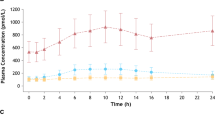Summary
The pharmacokinetics of propranolol (P) and its major metabolites, propranolol glucuronide (PGLUC), 4-hydroxypropranolol (4OHP), 4-hydroxypropranolol glucuronide (4OHPGLUC) and naphthoxylactic acid (NLA), (Walle et al. 1972) were determined, whenever possible, in the first, second and third trimesters of pregnancy in thirteen patients and also when these patients were at least three months post-partum. No correlations were found between the mean arterial blood pressure (post-therapy) or the fall in blood pressure as a result of the P therapy (p> >0.05) and P dose, peak P plasma concentrations, peak 4-hydroxypropranolol (4OHP) plasma concentrations or peak (P plus 4OHP) plasma concentrations. However, a positive nonlinear relationship was found between the daily P dose (independent variable) and peak P plasma concentrations over the daily dose range 30–160 mg/day. The elimination half-lives of NLA for patients in the third trimester of pregnancy were significantly shorter (p=0.072, df=13) than those when the patients were at least three months post-partum. Also, the areas under the plasma level-time curves of NLA were significantly less (p<0.05, df=13) for patients in the third trimester of pregnancy than when these patients were at least three months post-partum. The results of this study indicate that the pharmacokinetics of P, PGLUC, 4OHP and 4OHPGLUC are not significantly altered by pregnancy. However, the kinetics of NLA do appear to be altered. The formation of NLA by N-dealkylation of P and further oxidation, appears to be competitively inhibited by unidentified substances, perhaps endogenous steroids, especially in the third trimester when compared to at least three months post-partum.
Similar content being viewed by others
References
Davis M, Simmons GJ, Doroni B, Maxwell JD, Williams R (1973) Induction of hepatic enzymes during normal human pregnancy. J Obstet Gynaecol Br Commonw 81: 690–694
Dettli L (1975) Elimination kinetics and drug dosage in renal insufficiency patients. Triangle 14: 117–123
Gibaldi M, Perrier D (1975) In: Swarbrick J (ed) Pharmacokinetics, vol. 1. Drugs and the pharmaceutical sciences. Marcel Dekker, New York, pp 57 and 151
Gugler R, Hobel W, Bodem G, Dengler HJ (1975) The effect of pindolol on exercise induced cardiac acceleration in relation to plasma levels in man. Clin Pharmacol Ther 17: 127–133
Gugler R, Krist R, Raczinski H, Hoffgen K, Bodem G (1980) Comparative pharmacodynamics and plasma levels of β-adrenoreceptor blocking drugs. Br J Clin Pharmacol 10: 337–343
Johnsson G, Regardh CG (1976) Clinical pharmacokinetics of β-adrenoreceptor blocking drugs. Clin Pharmacokinet 1: 233–263
Kosman ME (1973) Current status of propranolol hydrochloride (Inderal). J Am Med Assoc 225: 1380
Livingstone I, Craswell PW, Bevan BE, Smith MT, Eadie MJ (1983) Propranolol in pregnancy: Three year prospective study. Clin Exp Hypertens Pregnancy B2 [2]: 341–350
Marquardt DM (1963) An algorithm for least-squares estimation of nonlinear parameters. J Soc Ind Appl Math 11: 431–441
Smith MT, Livingstone I, Hooper WD, Eadie MJ, Triggs EJ (1983) Propranolol, propranolol glucuronide and naphthoxylactic acid in breast milk and plasma. Ther Drug Monit 5: 87–93
Walle T, Gaffney TE (1972) Propranolol metabolism in man and dog: Mass spectrometric identification of six new metabolites. Clin Pharmacol Ther 182: 83–92
Walle T, Conradi EC, Walle UK, Fagan TC, Gaffney TE (1978) The predictable relationship between plasma levels and dose during chronic propranolol therapy. Clin Pharmacol Ther 24: 668–677
Walle T, Conradi EC, Walle UK, Fagan TC, Gaffney TE (1979a) Naphthoxylactic acid after single and long-term doses of propranolol. Clin Pharmacol Ther 26: 548–554
Walle T, Fagan TC, Conradi EC, Walle UK, Gaffney TE (1979b) Presystemic and systemic glucuronidation of propranolol. Clin Pharmacol Ther 26: 167–172
Walle T, Gaffney TE (1980a) 4-hydroxypropranolol and its glucuronide after single and long-term doses of propranolol. Clin Pharmacol Ther 27: 22–31
Walle T, Conradi EC, Walle UK, Fagan TC, Gaffney TE (1980b) Propranolol glucuronide cumulation during long-term propranolol therapy: A proposed storage mechanism for propranolol. Clin Pharmacol Ther 27: 686–695
Author information
Authors and Affiliations
Rights and permissions
About this article
Cite this article
Smith, M.T., Livingstone, I., Eadie, M.J. et al. Chronic propranolol administration during pregnancy. Eur J Clin Pharmacol 25, 481–490 (1983). https://doi.org/10.1007/BF00542115
Received:
Revised:
Accepted:
Issue Date:
DOI: https://doi.org/10.1007/BF00542115




